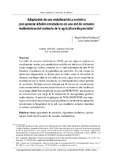Mostrar el registro sencillo del ítem
Adaptación de una metaheurística evolutiva para generar árboles enrutadores en una red de sensores inalámbricos del contexto de la agricultura de precisión
Adapting an evolutionary metaheuristic to generate routing trees in a wireless sensor network in the context of precision agriculture
| dc.contributor.author | Rodríguez Vivas, Angela María | |
| dc.contributor.author | Corrales Muñoz, Juan Carlos | |
| dc.date.accessioned | 2017-06-29T22:22:34Z | |
| dc.date.available | 2017-06-29T22:22:34Z | |
| dc.date.created | 2016-12-31 | |
| dc.identifier.issn | 1692-3324 | |
| dc.identifier.uri | http://hdl.handle.net/11407/3531 | |
| dc.description.abstract | Las redes de sensores inalámbricos (WSN, por sus siglas en inglés) son ampliamente usadas para monitorear variables de interés en fenómenos como campos de cultivo, contexto en el cual la inclusión de una WSN fortalece el quehacer de la agricultura de precisión. En este campo de aplicación surgen retos de diseño para las redes como la necesidad de alcanzar una longevidad de los nodos sensores (que sirven como fuente de datos) de por lo menos seis meses que corresponde al periodo de sembrado. Trabajos previos afirman que la técnica de enrutamiento usada en una red de sensores inalámbricos es un factor de alta incidencia en su longevidad. En este artículo se presenta MOR4WSN, una propuesta de enrutamiento que surge de la adaptación de un algoritmo genético multi-objetivo. A partir de despliegues de WSN, MOR4WSN crea topologías con estructura jerárquica que permitan un enrutamiento apropiado preservando la longevidad de la red. Los resultados actuales muestran resultados prometedores. | spa |
| dc.description.abstract | Wireless sensor networks (wsn) are widely used to monitor variables of interest in phenomena such as crop fields. In such a context the inclusion of a wsn strengthens the task of precision agriculture. For networks used in precision agriculture design challenges have emerged, like the need to achieve longevity for sensor nodes (serving as a data source), of not less than six months, corresponding to the cultivation periods. Previous works say that the routing technique used in wireless sensor networks is a high incidence factor in its longevity. In this paper, mor4wsn, a routing proposal coming from the adaptation of a multi-objective genetic algorithm (moga) approach is presented. mor4wsn creates tree structures from wsn deployment for proper routing to preserve the longevity in a wsn. Preliminary evaluation shows promising results. | spa |
| dc.format.extent | p. 63-80 | spa |
| dc.format.medium | Electrónico | spa |
| dc.format.mimetype | application/pdf | |
| dc.language.iso | spa | |
| dc.publisher | Universidad de Medellín | spa |
| dc.relation.uri | http://revistas.udem.edu.co/index.php/ingenierias/article/view/1061 | |
| dc.rights.uri | http://creativecommons.org/licenses/by-nc-sa/4.0/ | * |
| dc.source | Revista Ingenierías Universidad de Medellín; Vol. 15, núm. 29 (2016); 63-80 | spa |
| dc.source | 2248-4094 | spa |
| dc.source | 1692-3324 | spa |
| dc.subject | Precision agriculture | spa |
| dc.subject | Evolutionary algorithms | spa |
| dc.subject | Multi-objective optimization | spa |
| dc.subject | Wireless sensor networks | spa |
| dc.subject | Agricultura de precisión | spa |
| dc.subject | Algoritmos evolutivos | spa |
| dc.subject | Optimización multi-objetivo | spa |
| dc.subject | Redes de sensores inalámbricos | spa |
| dc.title | Adaptación de una metaheurística evolutiva para generar árboles enrutadores en una red de sensores inalámbricos del contexto de la agricultura de precisión | spa |
| dc.title | Adapting an evolutionary metaheuristic to generate routing trees in a wireless sensor network in the context of precision agriculture | spa |
| dc.type | Article | eng |
| dc.rights.accessrights | info:eu-repo/semantics/openAccess | |
| dc.identifier.doi | http://dx.doi.org/10.22395/rium.v15n29a4 | |
| dc.relation.citationvolume | 15 | |
| dc.relation.citationissue | 29 | |
| dc.relation.citationstartpage | 63 | |
| dc.relation.citationendpage | 80 | |
| dc.audience | Comunidad Universidad de Medellín | spa |
| dc.publisher.faculty | Facultad de Ingenierías | spa |
| dc.coverage | Lat: 06 15 00 N degrees minutes Lat: 6.2500 decimal degreesLong: 075 36 00 W degrees minutes Long: -75.6000 decimal degrees | spa |
| dc.publisher.place | Medellín | spa |
| dc.creator.affiliation | Rodríguez Vivas, Angela María; Universidad del Cauca | spa |
| dc.creator.affiliation | Corrales Muñoz, Juan Carlos; Universidad del Cauca | spa |
| dc.relation.references | P. Rawat, K. D. Singh, H. Chaouchi, and J. M. Bonnin, “Wireless sensor networks: a survey on recent developments and potential synergies”, J. Supercomput., vol. 68, N.° 1, pp. 1–48, Apr. 2014. | spa |
| dc.relation.references | X. Cui and Z. Liu, “BCEE: a balanced-clustering, energy-efficient hierarchical routing protocol in wireless sensor networks”, in Network Infrastructure and Digital Content, 2009. IC-NIDC 2009. IEEE International Conference on, 2009, pp. 26–30. | spa |
| dc.relation.references | D. Emmen, “La agricultura de precisión: una alternativa para optimizar los sistemas de producción”, Investig. Pensam. Crít., Vol. 2, pp. 68–74, 2004. | spa |
| dc.relation.references | D. Villón Valdiviezo, “Diseño de una red de sensores inalámbrica para agricultura de precisión/ Daniel Villón Valdivieso”, 2011. | spa |
| dc.relation.references | A. Bari, S. Wazed, A. Jaekel, and S. Bandyopadhyay, “A genetic algorithm based approach for energy efficient routing in two-tiered sensor networks”, Ad Hoc Netw., vol. 7, N.° 4, pp. 665–676, Jun. 2009. | spa |
| dc.relation.references | C. C. Nayibe, T. B. D. Alexander, A. Z. L. Cristina, and C. O. L. Miguel, “Redes de Sensores Inalámbricos”. | spa |
| dc.relation.references | A. M. Rodríguez-Vivas, J.C. Corrales-Muñoz, “Adaptación del Algoritmo Genético para la Creación de Árboles de Enrutamiento en una Red de Sensores Inalámbricos”, Lámpsakos, N.° 10, pp. 34-42, 2013. | spa |
| dc.relation.references | A. León Javier, “Diseño e implementación en hardware de un algoritmo bio-inspirado”, Instituto Politécnico Nacional, México D. F., 2009. | spa |
| dc.relation.references | K. Deb, S. Agrawal, A. Pratap, and T. Meyarivan, “A fast elitist non-dominated sorting genetic algorithm for multi-objective optimization: NSGA-II”, Lect. Notes Comput. Sci., Vol. 1917, pp. 849–858, 2000. | spa |
| dc.relation.references | K. Deb, A. Pratap, S. Agarwal, and T. Meyarivan, “A fast and elitist multiobjective genetic algorithm: NSGA-II”, Evol. Comput. IEEE Trans. On, Vol. 6, N.° 2, pp. 182–197, 2002. | spa |
| dc.relation.references | O. Islam, S. Hussain, and H. Zhang, “Genetic algorithm for data aggregation trees in wireless sensor networks”, 2007. | spa |
| dc.relation.references | A. Chakraborty, S. Kumar, and M. Kanti, “A genetic Algorithm Inspired Routing Protocol for Wireless Sensor Networks”, International Journal of Computational Intelligence Theory and Practice, vol. 6 N.° 1, 2011. | spa |
| dc.relation.references | S. K. Gupta, P. Kuila, and P. K. Jana, “GAR: An energy efficient ga-based routing for wireless sensor networks”, in Distributed Computing and Internet Technology, Springer, 2013, pp. 267–277. | spa |
| dc.relation.references | A. Bari, S. Wazed, A. Jaekel, and S. Bandyopadhyay, “A genetic algorithm based approach for energy efficient routing in two-tiered sensor networks”, Ad Hoc Netw., Vol. 7, N.° 4, pp. 665–676, Jun. 2009. | spa |
| dc.relation.references | I. Apetroaei, I.-A. Oprea, B.-E. Proca, and L. Gheorghe, “Genetic algorithms applied in routing protocols for wireless sensor networks”, 2011, pp. 1–6. | spa |
| dc.relation.references | S. Yoo, J. Kim, T. Kim, S. Ahn, J. Sung, and D. Kim, “A 2 S: automated agriculture system based on WSN”, 2007, pp. 1–5. | spa |
| dc.relation.references | N. P. Karthickraja, V. Sumathy, and J. Ahamed, “A novel hybrid routing protocol for data aggregation in agricultural applications”, 2010, pp. 227–231. | spa |
| dc.relation.references | A. H. Kabashi and J. M. H. Elmirghani, “A Technical Framework for Designing Wireless Sensor Networks for Agricultural Monitoring in Developing Regions”, 2008, pp. 395–401. | spa |
| dc.relation.references | J. Panchard, S. Rao, J.-P. Hubaux, and H. S. Jamadagni, “COMMONSense Net: A Wireless Sensor Network for Resource-Poor Agriculture in the Semiarid Areas of Developing Countries”. Inf. Technol. Int. Dev., vol. 4, N.° 1, 2007. | spa |
| dc.relation.references | J. Hu, L. Shen, Y. Yang, and R. Lv, “Design and implementation of wireless sensor and actor network for precision agriculture”, 2010, pp. 571–575. | spa |
| dc.relation.references | A. M. Ortiz Torres, “Técnicas de enrutamiento inteligente para redes de sensores inalámbricos”. Tesis doctoral. Universidad de Castilla La Mancha. Albacete–España, 2011. | spa |
| dc.relation.references | A. Rodríguez, A. Ordóñez, A. Ordóñez, “Energy consumption optimization for sensor networks in the IoT”, IEEE Colombian Conference on Communications and Computing, 2015. | spa |
| dc.rights.creativecommons | Attribution-NonCommercial-ShareAlike 4.0 International | * |
| dc.identifier.eissn | 2248-4094 | |
| dc.type.coar | http://purl.org/coar/resource_type/c_6501 | |
| dc.type.version | info:eu-repo/semantics/publishedVersion | |
| dc.type.local | Artículo científico | spa |
| dc.type.driver | info:eu-repo/semantics/article | |
| dc.identifier.reponame | reponame:Repositorio Institucional Universidad de Medellín | spa |
| dc.identifier.repourl | repourl:https://repository.udem.edu.co/ | |
| dc.identifier.instname | instname:Universidad de Medellín | spa |
| dc.relation.ispartofjournal | Revista Ingenierías Universidad de Medellín | spa |



